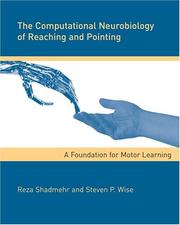| Listing 1 - 3 of 3 |
Sort by
|
Book
ISBN: 0262358719 9780262358712 9780262044059 0262044056 0262358700 Year: 2020 Publisher: Cambridge, Massachusetts : The MIT Press
Abstract | Keywords | Export | Availability | Bookmark
 Loading...
Loading...Choose an application
- Reference Manager
- EndNote
- RefWorks (Direct export to RefWorks)
"Why do we run toward people we love, but only walk toward others? Why do people in New York seem to be in a rush? Why do our eyes linger longer on things we value more? There is a link between how the brain assigns value to things, and how it controls our movements. This link is an ancient one, developed through shared neural circuits that on one hand teach us how to value things, and on the other hand control the vigor with which we move. As a result, when there is damage to systems that signal reward, like dopamine and serotonin, that damage not only affects our mood and patterns of decision making, but how we move. In this book, we first ask why in principle evolution should have developed a shared system of control between valuation and vigor. We then focus on the neural basis of vigor, synthesizing results from experiments that have measured activity in various brain structures and neuromodulators, during tasks in which animals decide how patiently they should wait for reward, and how vigorously they should move to acquire it. Thus, the way we move unmasks one of our well-guarded secrets: how much we value the thing we are moving toward"--
Reaction time --- Reward (Psychology) --- Decision making --- Physiological aspects. --- Deciding --- Decision (Psychology) --- Decision analysis --- Decision processes --- Making decisions --- Management --- Management decisions --- Choice (Psychology) --- Problem solving --- Motivation (Psychology) --- Reinforcement (Psychology) --- Response time (Psychology) --- Time, Reaction --- Psychophysiology --- NEUROSCIENCE/Neurobiology

ISBN: 0262195089 Year: 2005 Publisher: Cambridge, Mass. The MIT Press
Abstract | Keywords | Export | Availability | Bookmark
 Loading...
Loading...Choose an application
- Reference Manager
- EndNote
- RefWorks (Direct export to RefWorks)
Computer. Automation --- Affective and dynamic functions --- Physiology of nerves and sense organs --- 681.3*J3 --- Life and medical sciences (Computer applications) --- Motor ability. --- Motor learning --- Motor learning. --- Mathematical models. --- 681.3*J3 Life and medical sciences (Computer applications) --- Motor ability --- Motor skill learning --- Learning, Psychology of --- Movement, Psychology of --- Physical education and training --- Movement education --- Agility --- Coordination, Muscular --- Dexterity --- Manual dexterity --- Manual skill --- Motor control (Physiology) --- Motor dexterity --- Motor skill --- Motor skills --- Muscular coordination --- Skills, Motor --- Ability --- Kinesiology --- Mechanical ability --- Mathematical models
Book
ISBN: 0262016966 9786613448910 1283448912 0262301288 0262300508 9780262301282 9781283448918 9780262016964 Year: 2012 Publisher: Cambridge, Mass. MIT Press
Abstract | Keywords | Export | Availability | Bookmark
 Loading...
Loading...Choose an application
- Reference Manager
- EndNote
- RefWorks (Direct export to RefWorks)
In this work, the authors present a theoretical framework for understanding the regularity of the brain's perceptions, its reactions to sensory stimuli, and its control of movements.
MEDICAL --- Neuroscience --- Brain --- Neuropsychology --- Central Nervous System --- Psychology, Educational --- Psychological Phenomena and Processes --- Models, Biological --- Nervous System --- Models, Theoretical --- Psychiatry and Psychology --- Psychology, Applied --- Anatomy --- Investigative Techniques --- Analytical, Diagnostic and Therapeutic Techniques and Equipment --- Perception --- Mental Processes --- Learning --- Models, Neurological --- Human Anatomy & Physiology --- Health & Biological Sciences --- Mathematical models --- Brain. --- Neuropsychology. --- Mathematical models. --- Cerebrum --- Mind --- Neurophysiology --- Psychophysiology --- Central nervous system --- Head --- Models --- NEUROSCIENCE/General
| Listing 1 - 3 of 3 |
Sort by
|

 Search
Search Feedback
Feedback About UniCat
About UniCat  Help
Help News
News